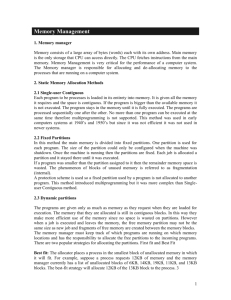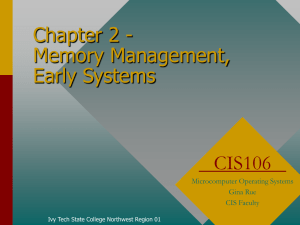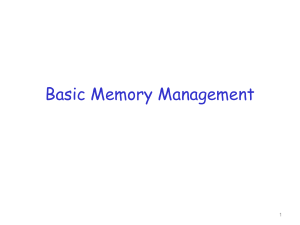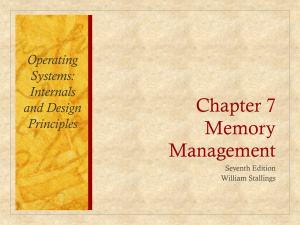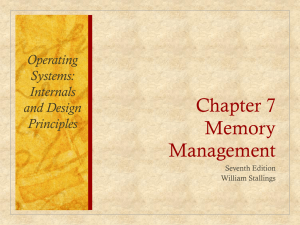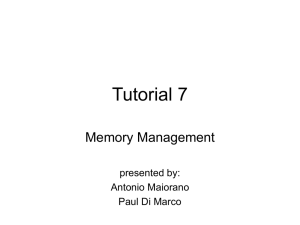Chapter 2 - Memory Management (Simple Systems)
advertisement
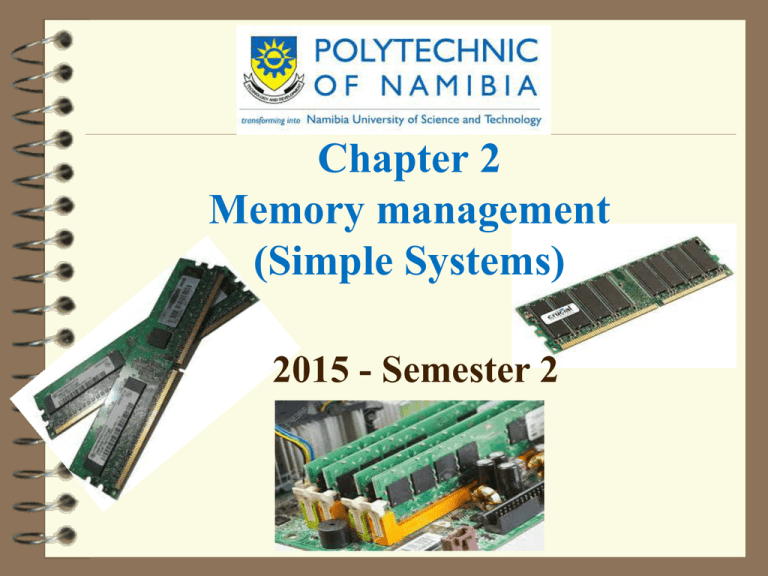
Chapter 2 Memory management (Simple Systems) 2015 - Semester 2 Objectives Introduction Four types of memory allocation schemes – Single-user contiguous scheme – Fixed partitions – Dynamic partitions – Relocatable dynamic partitions Fragmentation Memory allocation methods / algorithms First fit Best fit Deallocation Relocatable dynamic partition Introduction Management of main memory is critical Entire system performance dependent on two items – How much memory is available – Optimization of memory during job processing This chapter introduces: – Memory manager – Four types of memory allocation schemes • • • • Single-user systems Fixed partitions Dynamic partitions Relocatable dynamic partitions Introduction (cont.) Operating systems must employ techniques to – Track where and how a program resides in memory – Convert logical addresses into actual addresses Logical address (sometimes called a virtual or relative address) A value that specifies a generic location, relative to the program – is simply an integer value relative to the starting point of the program Physical address An actual address in the main memory device – is a logical address added to the starting location of the program in main memory Single - User Contiguous Scheme Commercially available in 1940s and 1950s Entire program loaded into memory Contiguous memory space allocated as needed Jobs processed sequentially Memory manager performs minimal work – Evaluates incoming process size; loads if small enough to fit, otherwise reject and evaluates next incoming process. Accumulator to track program size – Monitors occupied memory space when process end; makes entire memory space available and then checks for the next process. Disadvantages – No support for multiprogramming or networking – Not cost effective => unsuitable for business. – Program size must be less than memory size to execute Fixed partition Commercially available in 1950s and 1960s Main memory is partitioned – At system startup – One contiguous partition per job Permits multiprogramming Partition sizes remain static – Must shut down computer system to reconfigure Requires: – Protection of the job’s memory space – Matching job size with partition size Fixed partition (cont.) Memory Manager: allocates memory space to jobs – Information: stored in a table (table 2.1) A simplified fixed-partition memory table with the free partition shaded. © Cengage Learning 2014 Three types of program (figure 2.2) As the jobs listed in Table 2.1 are loaded into the four fixed partitions, Job 3 must wait even though Partition 1 has 70K of available memory. Jobs are allocated space on the basis of “first available partition of required size.” © Cengage Learning 2014 Fixed Partition Disadvantages – Requires contiguous loading of entire program – Job allocation method • First available partition with required size – To work well: • All jobs must be same size and memory size known ahead of time – Arbitrary partition size leads to undesired results • Partition too small – Large jobs have longer turnaround time • Partition too large – Memory waste: internal fragmentation Dynamic partition Main memory is partitioned – Jobs given memory requested when loaded – One contiguous partition per job Job allocation method – First come, first serve allocation method – Memory waste: comparatively small within partitions Disadvantages – Full memory utilization only during loading of first jobs – Subsequent allocation: memory waste • External fragmentation: fragments between blocks (figure 2.3) Main memory use during dynamic partition allocation. Five snapshots (a-e) of main memory as eight jobs are submitted for processing and allocated space on the basis of “first come, first served.” Job 8 has to wait (e) even though there’s enough free memory between partitions to accommodate it. © Cengage Learning 2014 Fragmentation External Fragmentation – total memory space exists to satisfy a request, but it is not contiguous. Internal Fragmentation – allocated memory may be slightly larger than requested memory; this size difference is memory internal to a partition, but not being used. Reduce external fragmentation by compaction Best-fit and First-fit Allocation Two methods for free space allocation – First-fit: first partition fitting the requirements • Leads to fast allocation of memory space – Best-fit: smallest partition fitting the requirements • Results in least wasted space • Internal fragmentation reduced, but not eliminated – Worst fit: Allocate program to the largest partition big enough to hold it Fixed and dynamic memory allocation schemes use both methods. Best-fit and First-fit Allocation (cont.) First-fit memory allocation Advantage faster in making allocation Disadvantage leads to memory waste Best-fit memory allocation Advantage Disadvantage makes the best use of memory space slower in making allocation First-fit (figure 2.5) Using a first-fit scheme, Job 1 claims the first available space. Job 2 then claims the first partition large enough to accommodate it, but by doing so it takes the last block large enough to accommodate Job 3. Therefore, Job 3 (indicated by the asterisk) must wait until a large block becomes available, even though there’s 75K of unused memory space (internal fragmentation). Notice that the memory list is ordered according to memory location. © Cengage Learning 2014 Best-fit (figure 2.6) Best-fit free scheme. Job 1 is allocated to the closest-fitting free partition, as are Job 2 and Job 3. Job 4 is allocated to the only available partition although it isn’t the best-fitting one. In this scheme, all four jobs are served without waiting. Notice that the memory list is ordered according to memory size. This scheme uses memory more efficiently but it’s slower to implement. © Cengage Learning 2014 Best-fit and First-fit Allocation (cont.) Check algorithms for both first fit and best fit in the textbook. Hypothetical allocation schemes Next-fit: starts searching from last allocated block, for next available block when a new job arrives Worst-fit: allocates largest free available block to new job – Opposite of best-fit – Good way to explore theory of memory allocation – Not best choice for an actual system Deallocation Deallocation: freeing allocated memory space For fixed-partition system: – Straightforward process – Memory Manager resets the status of job’s memory block to “free” upon job completion – Any code may be used – Example code: binary values with 0 (zero) indicating free and 1 (one) indicating busy For dynamic-partition system: – Algorithm tries to combine free areas of memory – More complex Deallocation (cont.) Three dynamic partition system cases, depending on position of block to be deallocated: – Case 1: When the block to be deallocated is adjacent to another free block – Case 2: When the block to be deallocated is between two free blocks – Case 3: When the block to be deallocated is isolated from other free blocks Look for examples regarding these cases in textbook Relocatable Dynamic Partitions Memory Manager relocates programs – Gathers all empty blocks together Compact the empty blocks – Make one block of memory large enough to accommodate some or all of the jobs waiting to get in Relocatable Dynamic Partitions (cont.) Compaction: reclaiming fragmented sections of memory space sections – Every program in memory must be relocated • Programs become contiguous – Operating system must distinguish between addresses and data values • Every address adjusted to account for the program’s new location in memory • Data values left alone (figure 2.9) Three snapshots of memory before and after compaction with the operating system occupying the first 10K of memory. When Job 6 arrives requiring 84K, the initial memory layout in (a) shows external fragmentation totaling 96K of space. Immediately after compaction (b), external fragmentation has been eliminated, making room for Job 6 which, after loading, is shown in (c). © Cengage Learning 2014 Relocatable Dynamic Partitions (cont.) (figure 2.11) Contents of the relocation register for Job 4 before the job’s relocation and compaction (a) and after (b). © Cengage Learning 2014 Relocatable Dynamic Partitions (cont.) What lists have to be updated? – Free list • Must show the partition for the new block of free memory – Busy list • Must show the new locations for all of the jobs already in process that were relocated – Each job will have a new address • Exception: those already at the lowest memory locations Relocatable Dynamic Partitions (cont.) Special-purpose registers used for relocation: – Bounds register • Stores highest location accessible by each program – Relocation register • Contains the value that must be added to each address referenced in the program • Must be able to access the correct memory addresses after relocation • If the program is not relocated, “zero” value stored in the program’s relocation register Relocatable Dynamic Partitions (cont.) Compacting and relocating optimizes use of memory – Improves throughput Options for timing of compaction: – When a certain percentage of memory is busy – When there are jobs waiting to get in – After a prescribed amount of time has elapsed Compaction entails more overhead Goal: optimize processing time and memory use while keeping overhead as low as possible Relocatable Dynamic Partitions (cont.) Compaction? When a certain % (e.g. 75) memory in is use Compact only at fixed time intervals Compact only when there are jobs waiting to enter There are advantages and disadvantages to each. Homework Read chapter 2 in the textbook!! End


